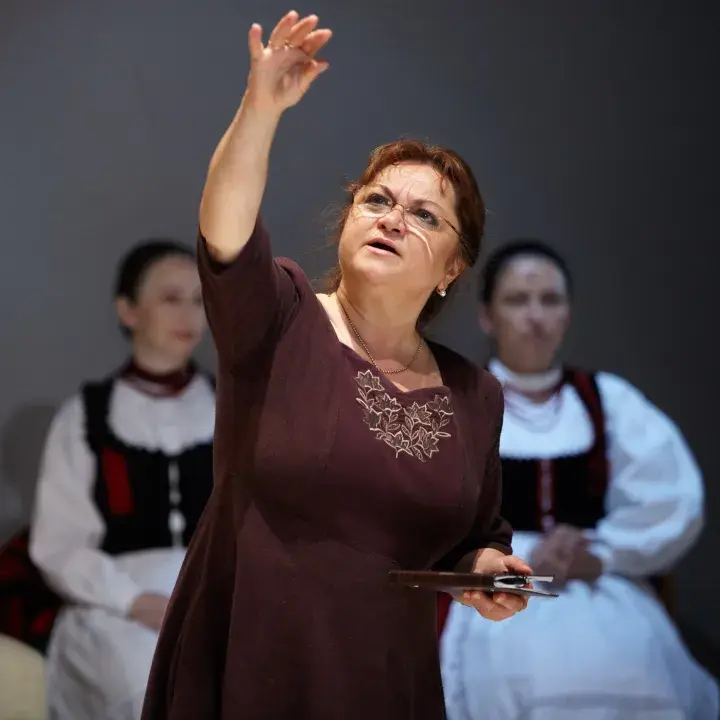Along with Paul Poiret and Elsa Schiaparelli, who "moved" to the Ethnographic Museum for two weeks in 1935 to examine Matyó pattern drawings, many fashion designers of the era came to Hungary to gain inspiration and study Hungarian folk motifs. Edward Molyneux, Robert Piguet and the American fashion designer Main Rousseau Bocher, also known as Mainbocher, did not leave out the "motif hongrois”-the Hungarian motive from his designs. Molyneux and Piguet both visited Budapest to learn about the motifs of folk embroidery. Mainbocher presented an evening gown decorated with wildflowers with a fan made of wheat ear and named it "hongrois". Among other things, Molyneux visited Klára Tüdős' salon, where he bought two of her works out of sheer enthusiasm. "Molyneux, the world-famous fashion creator, was fascinated not only by Budapest but also by the Hungarian fashion. He admired the gorgeous Hungarian-style dresses in the newly-opened salon of the most famous Hungarian designer, Klári Tüdős (Mrs Szunyogh), "Pántlika" at 6 Kristóf Square. Originally, he only wanted to study the dresses, but he liked them so much that he immediately bought and took two pieces: a woven wool striped sports jacket and a ski jacket with a shepherd's cloak cut embroidery, so now it's sure that Mrs Szunyogh's creations will turn into world fashion." - wrote Böske Guthy.
Böske Guthy was one of the most important fashion icons and fashion correspondents of the time. In the magazine Theatrical Life columns, she repeatedly reported that the well-to-do foreign ladies preferred Hungarian folk motifs on their clothes much more than the ladies of Budapest, who "were staring" at them. In 1936, she said: "A foreign lady wanted to wear Hungarian fashion. Over her floral silk gown, she was wearing a white, richly embroidered shepherd's cloak. Our ladies were staring at it while many foreign ladies were delighted with the cloak. One of London's most elegant fashion icons even promised to wear such a cloak in the summer at the Salzburger Festspiele. In general, there is a strong interest in Hungarian fashion. Regardless of the kind efforts of the Minister of Industry, namely that Hungarian women should embrace Hungarian fashion and turn Hungarian fashion items into global phenomena, gradually, the fashion ladies of Budapest are also beginning to realise that not all are bad and funny. That is Hungarian. If Mainbocher in Paris is allowed to present an evening dress decorated with wildflowers, called "hongrois", with a fan made of giant wheat ears, why can we not wear small boleros decorated with Hungarian embroidery for white summer dresses or Hungarian bodices instead of the dirndl of Tyrol in our summer cottages? You could decorate wide straw hats with Hungarian embroidered ribbons, black afternoon gowns, and velvet evening jackets with old Hungarian minted silver buttons. There are thousands of small shades of fashion where the Hungarian trend could prevail and which would certainly be taken over by other nationalities (let's not laugh since even Schiaparelli and Piquet have come to Budapest for fashion ideas). With this, we could achieve that our home industry exports, which have grown to six million this year, would grow even higher. Who would believe the statisticians, according to which, over the past year, we have exported 600,000 Hungarian embroidered blouses? If Salzburg was able to create Tyrolean fashion through Lainz's shop and the dirndls of Viennese ladies, why not let the Budapest fashion salons create some Hungarian-style fashion in the framework of our beautifully growing tourism?" Unfortunately, Hungarian folk art was also appropriated by politics. In 1938, when Miklós Horthy visited Hitler, Göring's wife appeared at the Berlin opera, "in a white Hungarian dress" as a diplomatic gesture.


